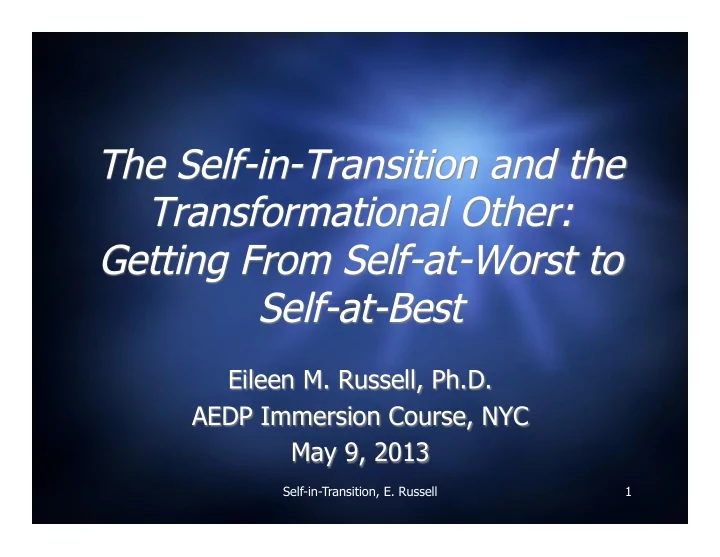

The Self-in-Transition and the Transformational Other: Getting From Self-at-Worst to Self-at-Best Eileen M. Russell, Ph.D. AEDP Immersion Course, NYC May 9, 2013 Self-in-Transition, E. Russell 1
Transformational Object …and this feature of early existence lives on in certain forms of object-seeking in adult life… rather, the object is pursued in order to surrender to it as a medium that alters the self-enviro-somatic caring, identified with metamorphoses of the self. The memory of this early object relation manifests itself in the person ’ s search for an object (a person, place, event, ideology) that promises to transform the self. (C. Bollas, Shadow of the Object, 1987 p. 14) Self-in-Transition, E. Russell 2
Our Focus Today ± Self-at-Worst & Self-at-Best ± Self-in-Transition ± Yellow Signal Affects ± Transformational Other ± Emergence and Elaboration of the True Self ± Essence of resilience Self-in-Transition, E. Russell 3
At ¡the ¡start ¡is ¡an ¡essential ¡ aloneness. ¡ ¡At ¡the ¡same ¡time ¡ this ¡aloneness ¡can ¡only ¡take ¡ place ¡under ¡maximum ¡ conditions ¡of ¡dependence. ¡ Winnicott, 1988 Self-in-Transition, E. Russell 4
Self-at-Worst & Self-at-Best Self-at-Worst Self-at-Best Effective Self Triggering Other Realistic Other Compromised Self Red Signal Soft Green Signal Defenses Affects Defenses Affects Emotion Emotion Pathogenic Affect, Unbearable States Core Affective Phenomena of Aloneness Self-in-Transition, E. Russell 5 Adapted from Fosha, 2013
The Case • 23 yo woman; recent college Grad. (Psych major) • Living with family members in city, not parents • Financially privileged background; emotionally impoverished. Parents highly narcissistic Middle child. Siblings both with learning disorders • Pt. initially with significant social phobia and general high anxiety. Frequent migraines since childhood • Frequently incoherent or circumstantial in speech • This session is 4 months into treatment. She stayed home sick from work. Self-in-Transition, E. Russell 6
Wired for Growth & Transformation ± Brain Plasticity ± Resilience ± Change in Attachment Status ± Therapeutic change and positive outcomes ± Attunement-Disruption-Repair ± Dreams ± Intuitive knowing of what is optimal ± Transformance (Fosha) ± Dyadic Elaboration of the Self Self-in-Transition, E. Russell 7
Self-in-Transition Tentative Self Transformational Other Wavering Yellow signal Defenses Affects Core Affect, Pathogenic Affects, Transformational Affects, Core State Self-in-Transition, E. Russell 8
About Yellow Signal Affects ± Marked by rapid alternating between green signals (of hope, curosity, openness, etc) and red signals (anxiety, shame, fear, etc) ± There is a sense of effort and persistence on the part of the patient ± Therapist may be unclear about where patient is Self-in-Transition, E. Russell 9
About the Self-in-Transition ± The Self-in-transition is a state in which a lot of the work of therapy takes place ± If you are doing moment-to-moment work, you should move relatively quickly away from the Self-at-Worst ± Basic approach to self-in-transition is to keep inviting into core affective experience until you get clear red signals or rigid defenses Self-in-Transition, E. Russell 10
The Transformational Other ± Based on experience of being transformed by another in early infancy ± Or ± Innate expectation of transformation – Expectation of Safe Vulnerability ± Facilitates identification and elaboration of the self Self-in-Transition, E. Russell 11
On the Inherently Dyadic Nature of the Transformational Other and the Emerging Self ± What makes an other transformational is her willingness to be used and the self ’ s willingness to use her ± A Transformational other helps to identify and elaborate emergent, true self experience ± A Transformational other is affected by the self Self-in-Transition, E. Russell 12
About the True Self ± It exists, even if only as a potential or an “ unthought known ” ± It wants to express itself; to be present and known ± It is calm and grounded and there is a sense of “ this is me ” ± It needs others to facilitate its coming into being and its ongoing elaboration ± It is not static. Even when not experienced in the moment, it exists as a potential and is in process of becoming. Self-in-Transition, E. Russell 13
The Four States: Getting to True Self Experience & Starting with True Self Experience State 1: Defense/ State 1: Defense/ Distress Distress State 2: Core Affect State 2: Core Affect State 3: Transform- State 3: Transform- ational Affect ational Affect State 4: Core State/ State 4: Core State/ True Self Experience True Self Experience Self-in-Transition, E. Russell 14
Resilience Self-in-Transition, E. Russell 15
“ On behalf of the Self ” l … The motto for all resilience processes. In other words, resilience processes are those that are oriented toward survival, self protection, constriction (preservation of energy) AND authenticity, actualization, and thriving… It ranges the gamut from “resistance/ defense” to “transformance/ expansion” or “flourishing ” Russell, in press 16 16
Resilience Potential & Resilient Capacity l Resilience Potential : innate possibility and force existing in all people that works constantly on behalf of the self to recover, bounce back, or at the very least, protect ourselves from adversity, hardship, and even trauma; it underlies both transformance (expansion) and resistance (conservation) l Resilient Capacity: an individual’s maximum ability to bounce back, recover, or protect the self at any given moment in time; this is a quantifiable factor Russell, in press 17
! ! Figure!1.1! Resilience!Flowchart! From ! Resistance!to!Transformance! ! ! ! ! ! ! RESTORED! ! GENERALIZED! ONGOING! RESILIENCE! ! TRANSFORMANCE/! RESISTANCE/! &!HEALING! ! HEALTH! PATHOLOGY! SelfPinP ! Transition! ! ! ! ! ! ! ! RESISTANCE! RESILIENT! TRANSFORMANCE! ! Self>at>Worst! CAPACITY! Self>at>Best! ! ! ! Insecure!attachments;! ! Secure!attachments;! trauma;!insufficient! ! sufficient!support/! support/resources;! ! inability!to!regulate! resources;!ability!to! ! intense!emotions;!prior! regulate!intense! ! experience!with! emotions;!prior! ! challenge/!adversity! The! experience!with! ! Resilience! challenge/!adversity! ! Potential! ! ! ! ! ! ! Self-in-Transition, E. Russell 18 ! Russell , !E.!(in!press).!!Restoring!resilience:!Transformative!therapy!at!work.!New! York:!W.W.!Norton!&!Co.!
Resilience is the Self’s differentiation from that which is aversive to it Russell, in press 19
Upcoming Book: Restoring Resilience: Transformative Therapy at Work Eileen M. Russell, Ph.D. W.W. Norton & Co. 20
Recommend
More recommend